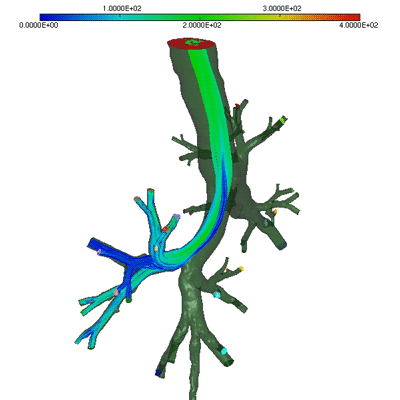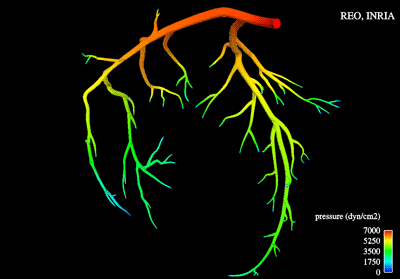The workshop focused on six main topics in medical imaging, modelling and simulation: 'Heart', 'Physiological Flows', 'Brain Imaging and Function', 'Composite Media, Multiscale Modelling, Optimal Shape and Design', 'Biological Systems, Cell and Tissues' and 'Implantable Medical Devices, Drug Delivery'. The workshop presentations are briefly summarized below, while a detailed description of the presentations is available at the URL provided at the end of the article.
Francois Fages (INRIA) spoke on formal cell biology using BIOCHAM software, and emphasized (1) rule-based modelling of biochemical reaction systems; (2) temporal logic formalization of biological properties; and (3) search algorithms for kinetic parameter values. Elementary rules include complexation/decomplexation, phosphorylation/ dephosphorylation, synthesis, transport and degradation.
Céline Grandmont (INRIA) talked on multiscale modelling of the respiratory tract, focusing on the thoracic airways from trachea to terminal alveolar duct. Her work is aimed at developing simple but representative models of small and mid-sized intraparenchymal airways either of the entire distal tracheobronchial tree or after compartment splitting. The simple flow model is coupled to a 3D Navier-Stokes model of incompressible air flow in large thoracic airways. Yves Bourgault (Ottawa University) carried out simulations of aerosol convection in airways using a compressible fluid solver.

André Garon (École Polytechnique de Montréal) and Marie-Isabelle Farinas (Université du Québec à Chicoutimi) presented the work carried out on a patient-specific model of steady flow in the carotid artery network in the context of implantation of a small (hence continuously operating mode) ventricular assist pump (VAD).
Jacques Bélair (Université de Montréal) gave a modelling example on erythropoiesis with age structure and variable life span. Erythrocyte (RBC) production is about 1012 cells per day, and production in various cellular compartments of erythropoiesis from stem cells and different progenitors has a given duration. RBC lifespan (120 days) is also incorporated into the equation. Conservation rules lead to PDEs that can be solved by the method of characteristics with given formulations of the degradation rate. Jean Clairambault (INRIA) works with Benoit Perthame on mathematical modelling of cell proliferation and its control, focusing on nanoprocesses within the cell to improve drug efficiency by taking into account the circadian cycle.
Irène Vignon-Clementel's (INRIA) talk focused on fluid-solid interaction in a porous medium, applied to heart perfusion. This work is part of the CardioSense3D INRIA initiative action. Solid grains and the fluid domain (viscous fluid governed by the Darcy law) are coupled. Heart matrix deformation is iteratively coupled to perfusion. Myocardium contraction transfers blood from the arterial to the venous compartment. A model of the large coronary artery network is coupled to the perfusion model, using a master interface between a Darcy and Navier-Stokes solver. Dominique Chapelle (INRIA) presented work from the CardioSense3D project, focusing on modelling of the heart's electromechanical coupling. Maxime Sermesant (INRIA) and co-workers have developed fast software for model-based diagnosis and therapy planning for heart diseases. Cardiac image processing combines various approaches, such as deformable model (LV), statistical shape model (RV), interactive segmentation (epicardium) and deformation tracking.

Raymond Spiteri (University of Saskatchewan) carried out a simulation of electrical heart activity in the framework of the virtual heart project. Ionic motions in excitable cardiomyocytes are represented by ordinary differential equations. The numerical model is based on operator splitting and specific IMEX-Rung-Kutta methods. Najib Zemzemi (INRIA) presented simulations of electrocardiograms. Alexandra Franchitti (INRIA) and Yvon Maday are studying optimization aspects for pacemaker treatment. Investigation of the effects of parameters of the fast-slow dynamics equation shows that reaction parameters affect both reaction and diffusion, whereas diffusion parameters only influence diffusion. Youssef Belhamadia (University of Alberta) proposed a numerical bidomain model of electrical waves in the heart.
Michel Sorine (INRIA) proposed a new signal processing method to assess arterial blood pressure. The analysis uses a scattering-based method (SBSA) to target pressure pulses with solitons.
Matteo Astorino (INRIA) works on fluid-structure interaction down to large contact with application to heart valves. Maurice Doyle (University of Ottawa) has studied blood flow in the presence of assist devices, and is now investigating blood flow coupled to deforming myocardium using Adina software. N. Morcos (INRIA) works on a reduced basis method for blood flow simulations in porous tissues (microcirculation). Two-scale homogenization is not periodic, and simulations require the resolution of a large number of parameterized cells. A reduced basis method based on weak formulation and relying on the Galerkin method allows computations to be sped up.
In collaboration with Leipzig University, Dirk Drasdo (INRIA) develops models of multicellular tissues, in particular tumour growth and liver regeneration. Tumour modelling must bridge large time and length scales, from a few cells to whole populations. Monolayer cell growth relies on cell-based models. Cell motion is governed by a stochastic equation, the random force associated with cell exploration of its environment being defined by statistical features.
Gérard Plante (Université de Sherbrooke) spoke on pharmacokinetics with a focus on drug delivery to the interticial fluid compartment that must be crossed to reach cells. Fahim Nekka (Université de Montréal) studies pharmacological intra/intervariability induced by patients' irregular drug intake. The adopted strategy allows pharmocokinetics and dynamics to be easily updated. Annabelle Ballesta (INRIA) and Jean Clairambault are studying the pharmacokinetics and dynamics of anticancer drugs in the cell, and are developing a model for anticancer drugs.
Christian Barillot (INRIA) presented data on neuroinformatics in the context of diseases of the central nervous system to develop computer-aided medicine and surgery tools. The work is being partially carried out by a team from INRIA and McGill University. New surgery rooms are equipped with computer infrastructure to integrate data from sensors, to control effectors, and to feed databases. Image quality is improved by a fast nonlocal method for image restoration and noise reduction that is adapted for various acquisition techniques and modes. Olivier Rousseau (Université d'Ottawa) is working on an iterative active contour algorithm applied to heart segmentation. Maureen Clerc (INRIA) processes magnetoelectroencephalography (MEG) signals to explore brain activity. Brain neurons undergo cycles of depolarization/ repolarization.
Jiri Patera (Université de Montréal) is working on Fourier-like transforms of digital data given on bound lattices of any dimension, symmetry or density. This technique can be applied to interpolate motions between two frames. Jiri Hrivnak (Université de Montréal) is working on two-dimensional (anti)symmetric multivariate exponential functions and corresponding Fourier transforms with Jiri Patera. In the same team, Matthieu Voorons (Université de Montréal) uses image interpolation based on Lie group theory and has developed an algorithm for block decomposition of images. Comparisons with classical methods show that there are fewer interpolation errors. The proposed method is faster and more accurate than traditional interpolation algorithms.
Frédéric Lesage (École Polytechnique de Montréal) gave a talk dealing with optical imaging of the spinal cord, and explained how a neuronal activity map can be obtained during visual excitations. Mathieu Dehaes (École Polytechnique de Montréal) works with Frédéric Lesage on stimulation of the brain cortex by visual excitations. Inverted curves are found that have a vascular origin. Jean-Marc Lina (École de Technologie Supérieure) is working on the processing of optical imaging signals.
Robert Owens (Université de Montréal) works on blood rheology and has developed a non-homogeneous constitutive model. André Fortin (Université Laval) also focused his talk on viscoelastic fluid flow and free surface problems that require unsteady, anisotropic, adaptive remeshing. Michel Fortin (Université Laval) presented a numerical procedure used to treat frictional contact in solid mechanics.
Jean Paul Zolésio (INRIA) spoke on hidden regularity by extractor for Neuman problems, after pointing out analogies under certain circumstances between the Maxwell equations, elasticity and wave equations using adequate formulation and boundary conditions in incompressible media. Michel Delfour (Université de Montréal) derived new equations for calculating dosage under pulsed flow conditions, which can be used in the design of coated stents to prevent restenosis.
Link:
http://www-rocq.inria.fr/im2im/
Please contact:
Marc Thiriet, IM2IM Working Group coordinator
INRIA, France
E-mail: Marc.Thirietinria.fr










